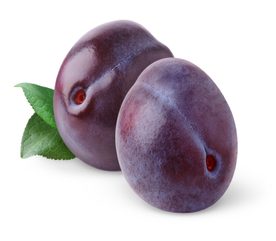Growing Plums: Common Plum Problems
There are over a hundred varieties of plums currently growing in Canada. Some of these are commerical, others are experimental and of course most are in our own gardens. Plums are adaptable and hardy, making them the second most popular fruit to grow (next to apples) in Canadian gardens. But, as with any plant or fruit, we must keep a close eye to make sure it’s growing properly and healthily. The fungal diseases black knot and brown rot are fairly common on plums.

|
SYMPTOMS AND SIGNS |
CAUSE |
CONTROL |
|
Fruits have small skin blemishes; insides may show corky brown streaks. Maggots (“worms”) are visible. |
Apple maggots (fly larvae) |
Pick up and dispose of fallen fruit daily. Hang red sticky ball traps in trees. |
|
Leaves and young shoots are twisted and stunted. Tiny, sticky insects are present. |
Leaf-curl plum aphids |
Carefully timed sprays of horticultural oil will kill these aphids as they hatch. Or, apply neem when aphids are seen on leaves. |
|
Leaves are eaten or spun together. Green caterpillars are usually present. |
Moth larvae |
Spray with Bacillus thuringiensis kurstaki as soon as damage is noticed. |
|
Small crescent-shaped scars on fruit, which drop early. |
Plum curculios (weevils) |
Pick up fallen fruits frequently. Once petals start to fall, each day spread a sheet below the tree and hit the tree trunk with a padded stick; collect and destroy the curculios that fall onto the sheet. Continue for 3 wk. |
|
Brown corky areas are visible on twigs and leaves. |
Scale insects |
Spray with dormant oil at bud break. Also, summer oil can be sprayed as contact control in late spring when new scales (“crawlers”) appear. Be sure to prune out badly infected branches. |
|
Leaves have pale or reddish mottling and may fall prematurely. |
Spider mites |
To kill eggs, spray with dormant oil while trees are dormant in winter. Plant ground covers to attract mite predators. Spray with insecticidal soap in summer. |
|
Smoky black knots (galls) on twigs and limbs, which range in size from 1 to 30 cm. |
Black knot (fungus) |
Plant resistant cultivars, such as ‘President’ and ‘Shiro’. Prune off galls. Make sure to cut at least 10 cm below swellings. |
|
Fruits have brown powdery masses. Fruits shrivel and form “mummies.” |
Brown rot (fungus) |
Keep trees well pruned to encourage air circulation. Remove and destroy dropped fruit. Spray with sulfur at preblossom stage. Repeat when flower shucks split, then weekly for 2 wk. |
|
Leaves turn brown and look burned, hang down from the branch, but do not fall. Cankers arise on branches. |
Fire blight (fungus) |
Spray with copper or fungicidal soap as soon as seen. Collect and dispose of fallen leaves. |
|
Small purple spots on leaves become brown and leaves may fall early. |
Pear leaf blight (fungus) |
Cut out affected branches to 15 cm below point where brown stain ceases. Paint all wounds with Bordeaux mixture. Feed, mulch, water, and/or drain as necessary to encourage vigor. A foliar feed may hasten recovery. |
|
Leaves have silvery sheen. Branches die back after 1 or more yr. When infected branches are cut out, wood shows dark brown staining. Small fungi appear on deadwood. |
Silver leaf (fungus) (mostly on West Coast) |
Cut out infected branches in midsummer. Spray foliage with Bordeaux mixture in midsummer, late summer, and midautumn. |
|
Brown spots may appear on leaves, eventually becoming holes. Flat cankers develop on stems and smaller branches; branches die back. |
Bacterial canker |
Applications of Bordeaux mixture at and after leaf fall are beneficial. Prune and destroy badly cankered twigs. Destroy infected leaves. |
|
Leaves, twigs, and fruits develop small spots that range in colour from pale green to deep purple or brown. Fruits may crack; twig cankers may develop. |
Bacterial leaf spot |
Root out and destroy infected plants. Disinfect all pruning tools with rubbing alcohol or diluted bleach solution (1 part bleach, 10 parts water). |
|
Large protuberances at soil line may girdle and kill entire tree. |
Crown gall (bacteria) |
Plant virus-free stock. Destroy affected plants. |
|
Narrow strap-shaped leaves are brittle, thick, and coarsely wrinkled. |
Prune dwarf (virus) |
No effective control. Infected plant material must be destroyed. Control of insects tends to reduce spread of disease. |
|
Leaves have yellow rings and spots. Fruits develop surface bumps and may drop from tree. |
Ring spot (virus) |
Improve drainage. Test soil to determine whether addition of lime is necessary. |
|
Stems and sometimes small branches die back. Plant lacks vigor. |
Problem soil conditions |
Plant resistant varieties. Apply streptomycin spray at early bloom stage. Prune out infected branches as soon as seen, cutting well into healthy wood. Apply Bordeaux mixture at the green-tip stage. |



